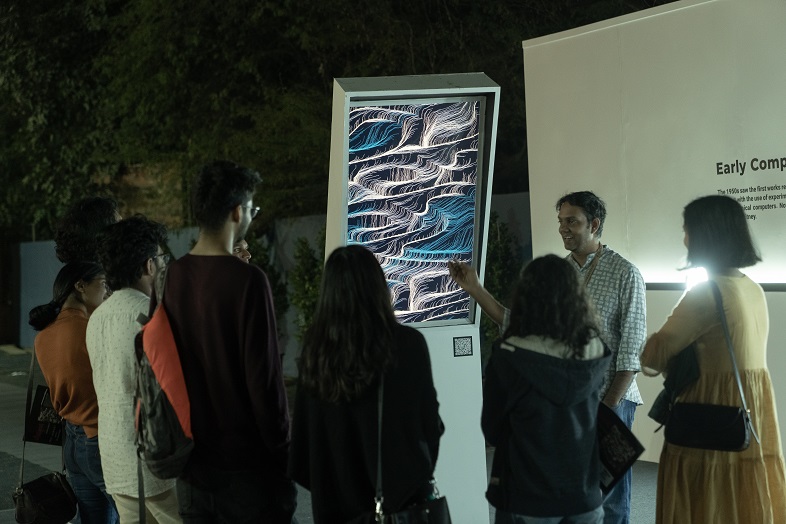Tezos Foundation and Tezos India presented ‘Computational Convergence’ art installation, fusing art and technology at IAF 2023

Synopsis: The India Art Fair 2023’s Outdoor Art Installation featured a large-scale Computational Art Installation titled “Computational Convergence” supported by Tezos Foundation in collaboration with Tezos India. The installation showcased the intersection of art and technology on a grand scale, giving visitors and art enthusiasts a unique opportunity to experience this union in an outdoor public space.
Art can be created using any media, but sometimes a medium is so powerful that it redefines itself, just like how digital art revolutionised what we know as “art.” The India Art Fair 2023 (IAF) which kicked off in New Delhi, on February 9th and concluded on February 12th, featured a massive Outdoor Art Installation titled ‘Computational Convergence,’ supported by Tezos Foundation in collaboration with Tezos India. It aimed at introducing computational art to IAF attendees and galleries marking a shift in the Indian mainstream art.
The installation featured a timeline of computational art in a large-scale format, chronicling its history from the 1950s to the present. Along with this it featured four 8-foot high kiosks with 800 editions of digital generative NFT art by 4 artists, Karthik Dondeti, Pixelkar नितान्त, Aranya (Ritesh Lala), and KALA (Ujjwal Agarwal), totaling 3,200 unique algorithmically generated masterpieces that fair visitors could freely collect via smartphone during the event. The artists got a chance to interact with the fair visitors to speak about their original concept, inspiration, and how they used code to create an algorithmic artwork with their own style and language.
Collecting art on the blockchain: Tezos India curated a unique installation allowing visitors to easily collect art using blockchain technology. The process of collecting NFTs is usually tedious with multiple steps, but this project aimed to make it more seamless. By scanning a QR code and entering their email, visitors could collect artwork in just three simple steps using fx hash and naan app. A PDF manual was also distributed for those interested in joining the Tezos ecosystem.
Tech meets Art: Tezos India hosted a workshop called “Computational Thinking” aimed at encouraging aspiring artists to use computational techniques to enhance their art. The workshop, facilitated by Karthik Dondeti and Pixelkar, helped visitors explore various ways of using computational tools to manipulate, visualise, and analyse data. The goal was to inspire creativity and show participants how to incorporate computational thinking into their artistic process.
Speaking about the installation, Varun Desai, Head of Tezos India Art & Culture, stated, “Tezos pioneers affordable digital art, low-carbon footprint, and forward-thinking blockchain projects. Tezos encourages creative blockchain usage for artists, collectors, galleries, and festivals, and educates people on smart contract development and art projects. Tezos aims to inspire Indian creative professionals to shape the future through blockchain technology.”
Artist Karthik Dondeti shared positive response to the generative art project at IAF 2023 and said, “Visitors were fascinated by technology and algorithm usage to create art, and engaged in discussions on the conceptualization process and digital translation. Code as a creative medium of expression is relatively new to most attendees, and many were keen to understand the process and rigour involved. Presentation to middle school students was a highlight, inspiring creative interest in code-based art.”
Algoscapes| Rock-face builds on past work on generating landscapes algorithmically (Algoscapes). The artwork is an attempt to capture the essence of naturally occurring rock faces through geometry and code.
Pixelkar नितान्त, the artist behind the ‘Computational Convergence’ installation, was delighted by the positive response of visitors at IAF. As a computational artist for almost a decade, he was amazed by the interest and curiosity shown by the visitors about the evolution of computational art and how blockchain is revolutionising the art form. He showcased some of his latest pieces that used rule-based instructions following traditional Rangoli formation principles resulting in interconnected, multi-dimensional monolithic forms of pixelated fragments of his memories. Visitors were captivated by the complexity, interactivity, and vibrancy of the pieces, which reinvigorated his passion for computational art.
“Some visitors were in absolute awe of using pure code as a medium for art, while some were in absolute disbelief. One of the interesting conversations I had with visitors was about the confusion between AI art and Generative Art, and it felt great to bust the myth,” he stated.
Rangxel by Pixelkar नितान्त | Rangxel is an interpretation of traditional Rangoli formations as tesseracts, combined to form monolithic structures which capture Fragments of Memories.
Artist Aranya (Ritesh Lala), based in New York, expressed his excitement about participating in the India Art Fair 2023, even though he was unable to attend. He was thrilled by the enthusiasm and appreciation of the visitors. He stated, “It’s amazing to be part of this significant moment when generative art is gaining recognition in India’s mainstream art world. I’m also excited about the opportunities this creates for South Asian artists to establish our own space in the future of computational art.”
Flow Meditations by Aranya (Ritesh Lala) | To flow is to expand and contract with the waves within. A tangled chaos of particles is unhindered with a deep breath and relaxation. With permission to flow, patterns emerge.
Artist KALA (Ujjwal Agarwal) expressed appreciation for the team’s efforts to educate visitors on the complex topics of blockchain, NFTs, and generative art, acknowledging that it was a challenging task in the modern world of short attention spans. He commended the team and expressed gratitude for their hard work.
| The Yoni Project is a generative art piece that explores the concept of the yoni, a Sanskrit word that refers to the female reproductive organ and is often used as a symbol of the goddess and the source of life in various Indic religions and other ancient cultures.
The event was a huge success, and we look forward to what next year has in store, given the overwhelmingly positive response from the audience.
